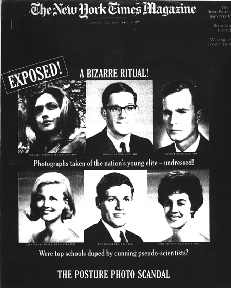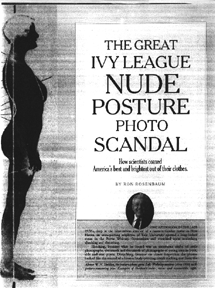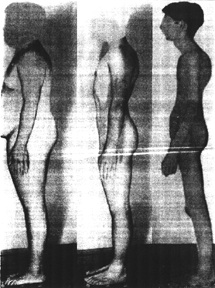


From as early as the 1880s to as late as the 1970s, college freshman at the nation's elite institutions were asked to strip naked as part of their freshman orientation and have "posture pictures" taken. Here's the story behind these pictures.
From: "The Great Ivy League Nude Posture Photo Scandal: How scientists coaxed America's best and brightest out of their clothes."
The New York Times Magazine (Jan. 15, 1995)
By Ron Rosenbaum
One afternoon in the late 1970's, an unsuspecting employee of Yale University opened a long-locked room in the Payne Whitney Gymnasium and stumbled upon something shocking and disturbing.
Shocking, because what he found was an enormous cache of nude photographs, thousands and thousands of photographs of young men in front, side and rear poses. Disturbing, because on closer inspection the photos looked like the record of a bizarre body-piercing ritual: sticking out from the spine of each and every body was a row of sharp metal pins.
The employee who found them was mystified. The athletic director at the time, Frank Ryan, a former Cleveland Browns quarterback new to Yale, was mystified. But after making some discreet inquiries, he found out what they were -- and took swift action to burn them. He called in a professional, a document-disposal expert, who initiated a two-step torching procedure. First, every single one of the many thousands of photographs was fed into a shredder, and then each of the shreds was fed into the flames, thereby insuring that not a single intact or recognizable image of the nude Yale students -- some of whom had gone on to assume positions of importance in government and society -- would survive.
It was the Bonfire of the Best and the Brightest, and the assumption was that the last embarrassing reminders of a peculiar practice, which masqueraded as science and now looked like a kind of kinky voodoo ritual, had gone up in smoke. The assumption was wrong. Thousands upon thousands of photos from Yale and other elite schools survive to this day.
. . . . . . . . . .
This is where things get really strange. Shortly after Cavett's reply, George Hersey, a respected art history professor at Yale, wrote a letter to The Times that ran under the headline "A Secret Lies Hidden in Vassar and Yale Nude 'Posture Photos.'" Sounding an ominous note, Hersey declared that the photos "had nothing to do with posture…that is only what we were told."
Hersey went on to say that the pictures were actually made for anthropological research: "The reigning school of the time, presided over by E. A. Hooton of Harvard and W. H. Sheldon" -- who directed an institute for physique studies at Columbia University -- "held that a person's body, measured and analyzed, could tell much about intelligence, temperament, moral worth and probable future achievement. The inspiration came from the founder of social Darwinism, Francis Galton, who proposed such a photo archive for the British population."
And then Hersey evoked the specter of the Third Reich: "The Nazis compiled similar archives analyzing the photos for racial as well as characterological content (as did Hooton). . . . The Nazis often used American high school yearbook photographs for this purpose. . . . The American investigators planned an archive that could correlate each freshman's bodily configuration ('somatotype') and physiognomy with later life history. That the photos had no value as pornography is a tribute to their resolutely scientific nature."
A truly breathtaking missive. What Hersey seemed to be saying was that entire generations of America's ruling class had been unwitting guinea pigs in a vast eugenic experiment run by scientists with a master-race hidden agenda. My classmate Steve Weisman, the Times editor who first called my attention to the letter, pointed out a fascinating corollary: The letter managed in a stroke to confer on some of the most overprivileged people in the world the one status distinction it seemed they'd forever be denied -- victim.










0 comments:
Posta un commento